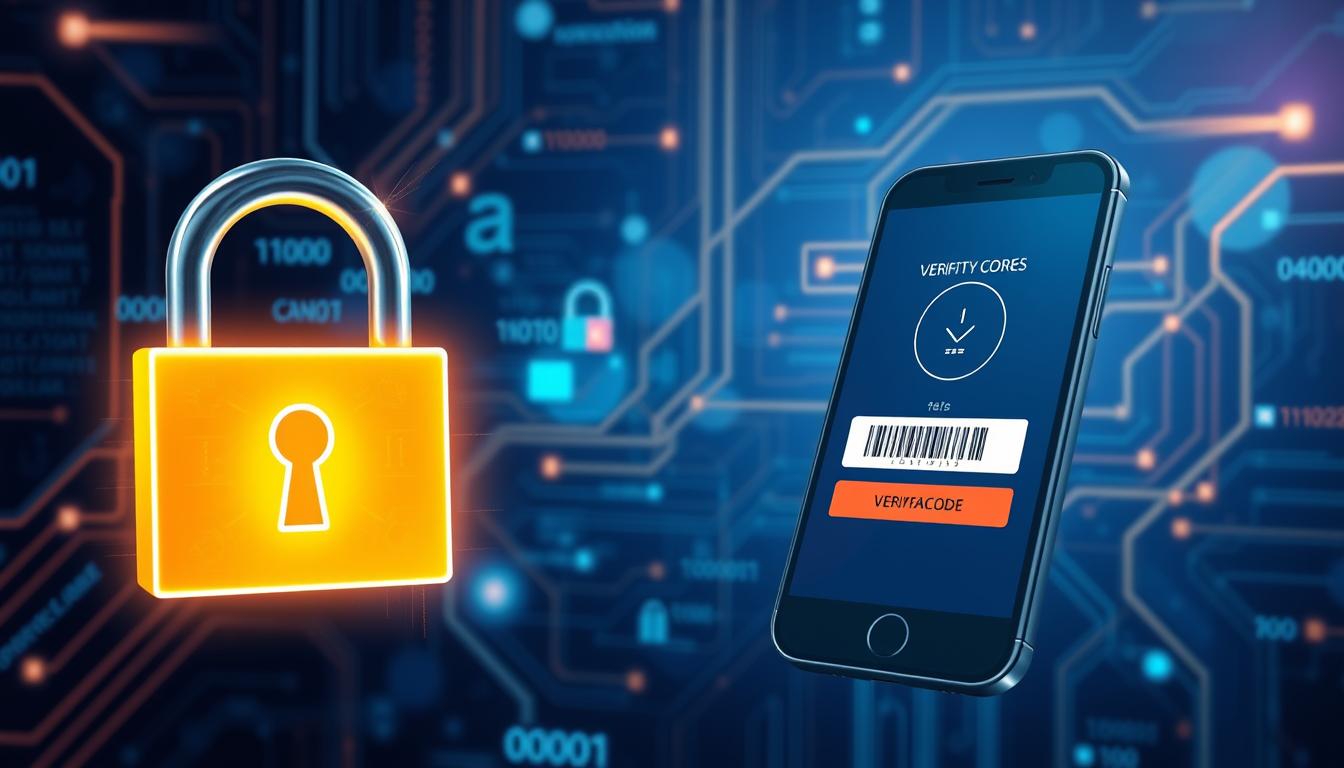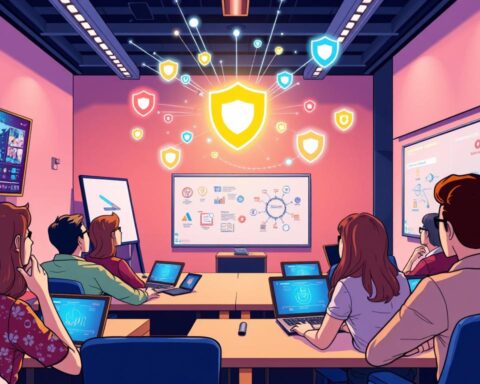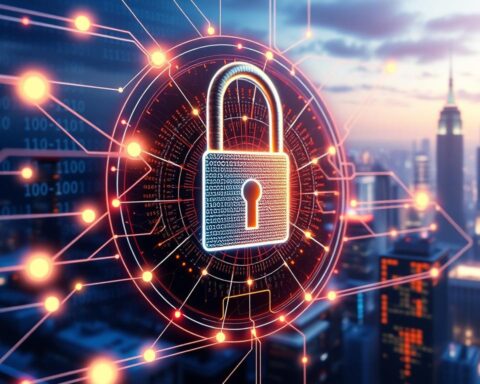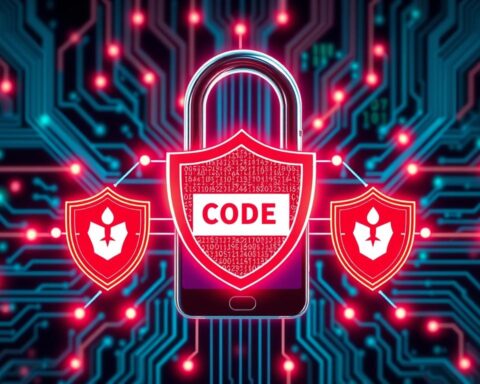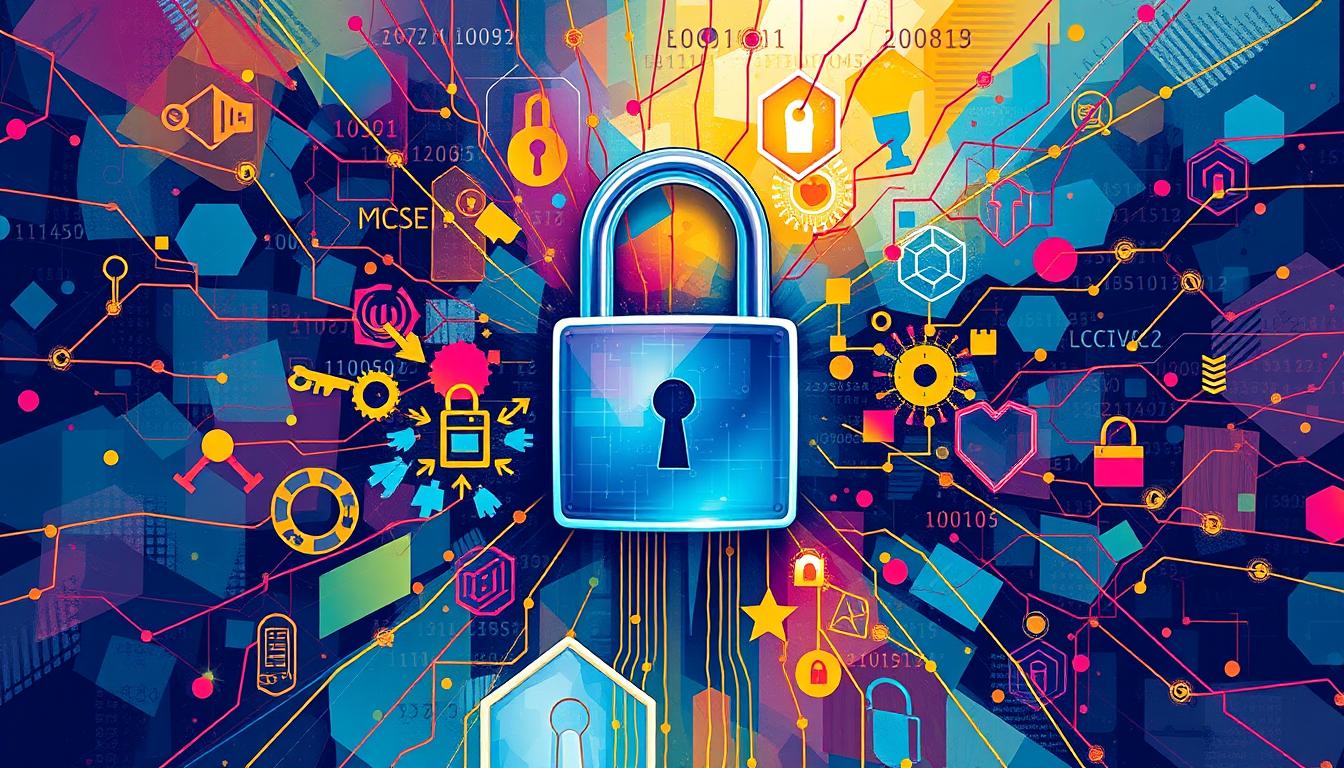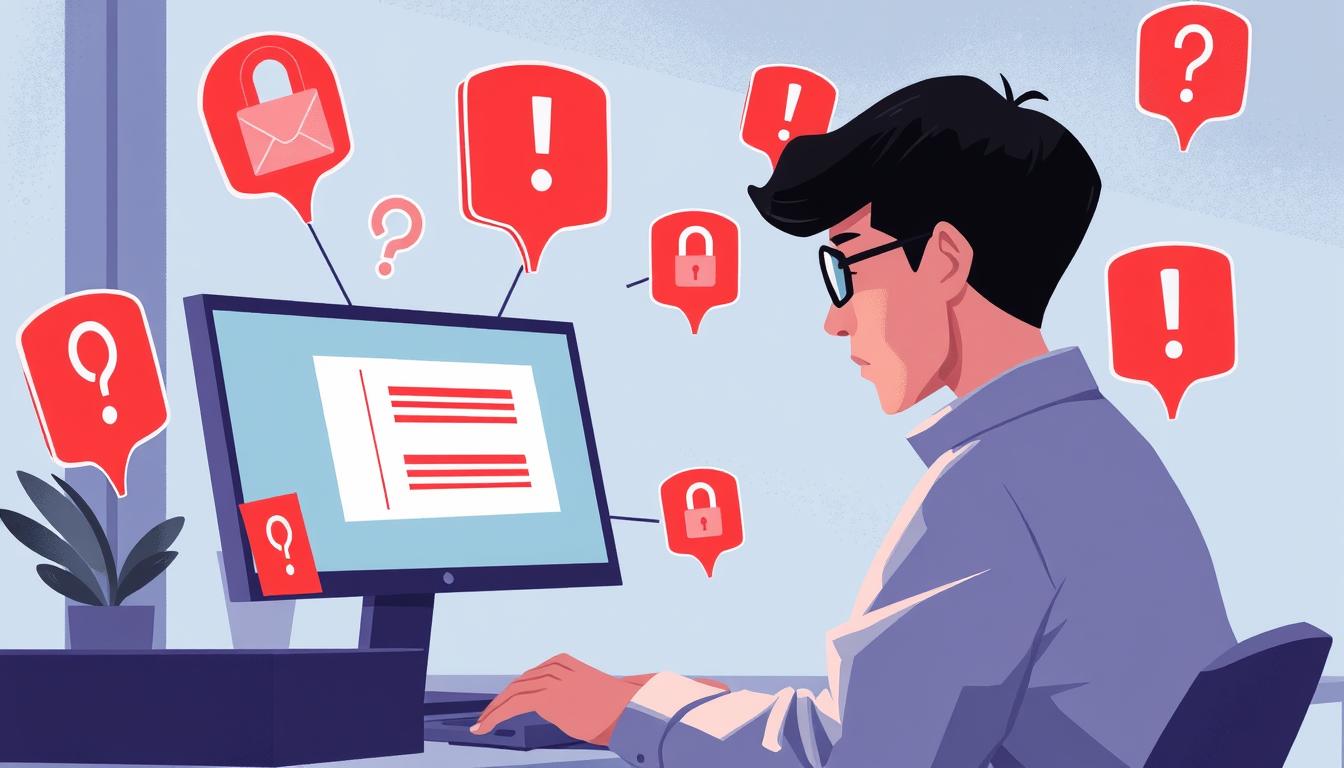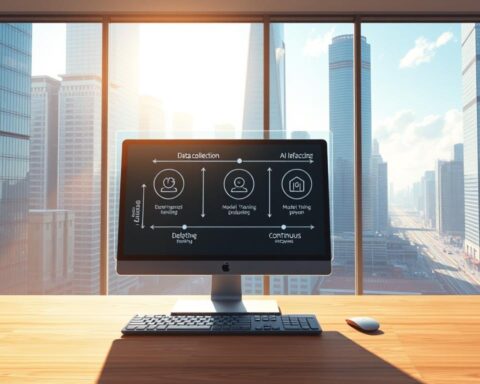Cybercrime is getting smarter, and 99.9% of attacks can be stopped with two-factor authentication (2FA)1. This shows how vital it is to protect our digital world better than just passwords.
We’re diving into multi-factor authentication, a game-changer for online safety. The market for 2FA is booming, set to grow from $3.5 billion in 2020 to $10.5 billion by 20262. It’s clear that companies are taking security seriously.
Two-factor authentication is more than a trend; it’s a must for our digital safety. It asks for two different things to log in, making it harder for hackers to get in, even if they guess your password.
Yet, only 50% of people use 2FA regularly, despite knowing it’s crucial2. This shows we need to do a better job teaching and using 2FA. As we learn more about cybersecurity, we’ll help you strengthen your online security.
Key Takeaways
- 2FA blocks over 99.9% of account compromising attacks
- The global 2FA market is expected to reach $10.5 billion by 2026
- Only 50% of users regularly use 2FA despite its proven effectiveness
- Common 2FA methods include SMS, push notifications, and biometrics
- Implementing 2FA can significantly reduce phishing attacks
- Organizations using 2FA report improved overall security posture
The Rising Threat of Cybercrime and Password Vulnerabilities
Cybercrime is growing fast, threatening both people and businesses. The digital world is full of dangers. So, it’s key to protect accounts and verify identities well.
Current Cybercrime Statistics and Trends
The world of cybercrime is scary. It’s expected to cause $10.5 trillion in damage by 2025. Ransomware attacks happen every 11 seconds3.
Small businesses are especially at risk. 43% of cyber attacks target them3. These facts show we need better password security fast.
Common Password Security Issues
Password weaknesses are a big problem in many places4. Only 28% of people use different passwords for all their accounts. This makes them easy targets for hackers34.
To fix this, experts say to use strong, random passwords of 16 characters or more. They also suggest using password managers4.
The Cost of Data Breaches
Data breaches are expensive and can harm a company’s reputation. The average cost for a business is $4.35 million. Sadly, 60% of small companies fail within six months after an attack3.
Even worse, 70% of breaches happen because of stolen or weak passwords. This shows how important strong authentication is3.
| Security Measure | Effectiveness |
|---|---|
| Two-factor authentication | Blocks 99.9% of automated attacks3 |
| Regular employee security training | Reduces insider threats by up to 75%3 |
| Multi-factor authentication (MFA) | Blocks up to 99.9% of automated attacks4 |
These numbers show we need to act fast to improve security. Using multi-factor authentication, password managers, and training employees can help a lot. They can lower the risk of cyber attacks and keep our data safe.
Two-Factor Authentication Explained: Adding an Extra Layer of Security
Two-factor authentication (2FA) adds a strong layer of protection to your online accounts. It asks for two different ways to prove who you are. This makes it harder for hackers to get in, making it key for keeping your data safe.
The role of 2FA is huge. It can cut down data breaches by up to 99.9% and stop 99.9% of automated cyber attacks56. This shows why over 80% of security experts see 2FA as essential5.
- Something you know (like a password)
- Something you have (like a mobile device)
- Something you are (like biometric authentication)
Since the COVID-19 pandemic, more businesses have started using 2FA. This is because more people are working from home and need better security5. But, there are still challenges. 63% of companies struggle with getting people to use 2FA6.
Biometric authentication is becoming more popular. 90% of users like using biometrics for 2FA because it’s easy and keeps them safe6. This is good news for the growing market of authentication solutions, which is expected to grow fast5.
| 2FA Method | Security Increase | User Preference |
|---|---|---|
| SMS Codes | 20x | Moderate |
| Hardware Tokens | 50% phishing reduction | Low |
| Biometrics | High | 90% |
Using 2FA helps protect your business and data. This is especially important for small businesses, as they are often targeted by hackers5. With a data breach costing around $4.24 million, using 2FA is a smart move5.
Understanding Authentication Factors in Cybersecurity
In today’s digital world, strong security is key. Two-factor authentication (2FA) is a powerful tool. It cuts down the risk of account hacking by up to 99.9% compared to just using a password7. Let’s look at why 2FA is so effective.
Knowledge Factors: What You Know
Knowledge factors are the most common. They include passwords, PINs, and security questions. But, they’re not perfect. Over 90% of security breaches come from weak or stolen passwords, showing we need more security7.
Possession Factors: What You Have
Possession factors add more security. They include physical items like security tokens, smart cards, or mobile devices. Mobile app authenticators have seen an 80% increase in use in the last two years7.
Inherence Factors: What You Are
Biometric authentication, like fingerprint scans or facial recognition, is under inherence factors. It’s becoming more popular, with the market expected to hit $30 billion by 20257. It’s a mix of security and convenience.
Location and Time-based Factors
Location and time-based factors add more security. They might limit access based on GPS or only allow login at certain times. These are great for companies with strict security rules.
| Factor Type | Examples | Assurance Level |
|---|---|---|
| Knowledge | Passwords, PINs | Low |
| Possession | Security tokens, Push authenticators | Medium |
| Inherence | Biometrics | High |
| Location/Time | GPS, Time restrictions | Varies |
Despite the benefits, only 30% of people use 2FA on their online accounts7. This shows a big chance to improve password security and multi-factor authentication. By using these different authentication factors, we can make our digital world safer.
How Two-Factor Authentication Works
Two-Factor Authentication (2FA) makes logging in safer by asking for two types of ID. This greatly lowers the chance of someone stealing your account8. It works well on many platforms, like Apple systems, Google Drive, and social networks8.
The 2FA process is simple:
- Enter your username and password
- Get a second verification step
- Use the second form of ID
- Get in once you’re verified
For instance, after your email and password, you might get a six-digit PIN via email8. This extra step means even if someone knows your password, they still need your phone or email to get in8.
| Factor Type | Examples |
|---|---|
| Knowledge | Passwords, PINs |
| Inherence | Fingerprints, Facial Recognition |
| Possession | Physical tokens, Smartphones |
Biometric methods, like fingerprints, are very secure because they’re hard to fake9. Some sites might ask for your birth date as an extra check8.
2FA alerts you right away if someone tries to get into your account, making it safer from hackers8. It’s a good mix of strong security and easy use, fitting different situations like where you are and what device you’re using9.
Types of Two-Factor Authentication Methods
Two-factor authentication (2FA) adds a crucial layer of security to your accounts. Let’s explore the most common 2FA methods and their effectiveness in protecting your digital identity.
SMS Text Message Authentication
SMS-based 2FA sends a one-time code to your phone. While widely supported, it’s vulnerable to SIM swapping attacks. Despite this, it’s still better than no 2FA at all, as enabling 2FA can prevent up to 99% of automated attacks on accounts1010.
Push Notification Systems
Push notifications offer a more secure and user-friendly alternative to SMS. They send alerts directly to your mobile device, requiring you to approve or deny login attempts. This method is gaining popularity as 67% of users prefer services with stronger authentication methods1010.
Biometric Authentication
Biometric authentication uses unique physical characteristics like fingerprints or facial features. This method is highly secure and convenient, as it’s based on what you are rather than what you know or have.
Hardware and Software Tokens
Tokens generate time-based one-time passwords for authentication. Software tokens, like mobile app authenticators, provide locally generated codes for enhanced security. Hardware tokens offer the highest level of protection, being immune to phishing and malware attacks1010.
When choosing a 2FA method, consider the balance between security and convenience. While SMS is widely available, authenticator apps and hardware tokens provide stronger protection for your sensitive accounts.
Implementation and Setup Guide for 2FA
Two-factor authentication (2FA) is a key security step that lowers the chance of unauthorized access. It requires two different factors to confirm identity. This makes it much harder for hackers to get into accounts, even if they guess passwords11.
Setting Up 2FA on Major Platforms
Many popular sites offer 2FA to make logins safer. Here’s a quick guide to turn on 2FA on some big services:
- Google: Go to your Google Account, click on “Security,” and select “2-Step Verification”
- Microsoft: Access your account settings, navigate to “Security,” and choose “Two-step verification”
- Facebook: Head to “Settings & Privacy,” then “Settings,” and “Security and Login”
Mobile Device Configuration
Mobile app authenticators are key for keeping accounts safe. To set up an authenticator app:
- Download a good authenticator app (e.g., Google Authenticator, Microsoft Authenticator)
- Open the app and follow prompts to add your account
- Scan the QR code provided by the service you’re securing
- Enter the generated code to finish setup
Business Implementation Strategies
Companies can greatly improve their security with 2FA. Studies show that 45% of organizations with 2FA see fewer cyber attacks. Also, employees are 30% more likely to use strong passwords with 2FA11.
| Sector | 2FA Adoption Rate |
|---|---|
| Financial | 49% |
| Healthcare | 38% |
To add 2FA in a company, you need a plan:
- Teach employees about 2FA’s importance and how to use it
- Pick a 2FA method that fits your business
- Slowly add 2FA to your systems
- Keep an eye on how it’s working and make changes as needed

By following these steps, businesses can build a strong security system. Remember, 2FA can cut breach risks by up to 99.9% when paired with strong passwords11.
Security Benefits and Effectiveness of 2FA
Two-factor authentication (2FA) is a key tool in keeping our digital world safe. It’s very good at protecting our online stuff. Microsoft says 2FA can stop over 99.9% of bad guys trying to get into accounts12.
2FA really helps cut down on security breaches. Since over 80% of hacking attacks use weak passwords, 2FA adds a much-needed extra layer of safety12. In fact, accounts with 2FA are 97% less likely to get hacked than those with just passwords13.
2FA does more than just stop hackers. It also helps companies follow the law. Laws like GDPR and HIPAA say you need 2FA to keep sensitive info safe. This way, companies can avoid big fines12.
Most people feel safer when they use 2FA, with about 60% saying it makes them feel more secure13. This feeling, along with the real security it offers, has made 2FA more popular. In the last year, its use has gone up by 25%13.
| Metric | Value |
|---|---|
| Account compromise reduction | 99.9% |
| Likelihood of compromise reduction | 97% |
| User perception of increased security | 60% |
| 2FA adoption increase (past year) | 25% |
Even though 2FA is really good, only 29% of online users use it when they can13. This shows we still need to teach more people about the importance of strong online security.
Common Challenges and Solutions in 2FA Adoption
Two-factor authentication (2FA) makes logging in more secure. But, it’s not easy to get everyone to use it. Knowing the problems helps make 2FA work better for everyone.
User Experience Considerations
Many users don’t like 2FA because they think it’s too hard. More than half of them say it slows them down too much14. To fix this, companies can give users different ways to log in. This way, everyone can find a method they like better15.
Technical Integration Issues
Getting 2FA to work with old systems is hard. About 30% of companies struggle with this14. They need 2FA that can grow with their users and technology15.
Recovery Options and Backup Methods
When users lose their second factor, it can cause big problems. It’s important to have backup ways to log in15. Some companies are looking into ways to make logging in easier and safer16.
| Challenge | Solution |
|---|---|
| User Resistance | Offer multiple 2FA options |
| Legacy System Compatibility | Implement scalable 2FA solutions |
| Operational Disruptions | Provide backup authentication methods |
By tackling these problems, companies can make logging in safer and easier. Keeping 2FA up to date helps fight off new threats15. You can learn more about how to improve your login security here.
Best Practices for Managing 2FA in Organizations
Using two-factor authentication (2FA) is a strong way to boost cybersecurity and identity checks. GitHub now requires all users to turn on 2FA, showing its key role in security17.
Research shows 2FA can stop up to 99.9% of automated attacks and cut phishing success by 50%. This proves it’s great for keeping data safe18. To get the most out of 2FA, follow these tips:
- Create clear 2FA policies
- Provide employee training
- Choose the right 2FA methods
- Make it work with your current systems
- Do regular security checks
It’s important to make 2FA easy for users while keeping it secure. Using Single Sign-On (SSO) can make work 20% better and cut down on password help by 50%18.
Teaching employees about 2FA is key. Tell them why it’s important and show them how to set it up. This can make security 70% better, as seen in places that use 2FA18.
Finally, check your 2FA often to see if it’s working well. Look at logs to see if everyone is following the rules and find ways to get better. Since 85% of people think 2FA is safe, it’s a smart move for any company’s security plan18.
Conclusion
Two-factor authentication (2FA) is key in fighting cybercrime. It adds a layer of security beyond just passwords. This makes 2FA a game-changer in the world of cybersecurity.
It can block 100% of automated bot attacks19. This shows how powerful it is.
The need for strong authentication is clear. In 2020, over 80% of cyber breaches were due to stolen passwords. The cost of a single data breach hit $4.24 million in 202120.
2FA requires two out of three factors: something you know, have, or are. This greatly lowers the chance of unauthorized access19.
Looking ahead, 2FA will become more common in different areas. It’s already being used in social media and financial institutions19.
Companies that use 2FA are often more trusted by their customers. This is especially true for financial transactions20. By using 2FA, we can make our digital world safer.
FAQ
What is two-factor authentication (2FA)?
How does 2FA improve security compared to traditional passwords?
What are the different types of authentication factors used in 2FA?
What are some common 2FA methods?
How effective is 2FA in preventing cyberattacks?
Can 2FA be bypassed or hacked?
How do I set up 2FA on my accounts?
What should I do if I lose access to my second factor?
Is 2FA necessary for all my online accounts?
How does 2FA impact user experience?
Source Links
- What Is Two Factor Authentication (2FA) And Why Do You Need It? – https://www.cyberpilot.io/cyberpilot-blog/what-is-two-factor-authentication-2fa-and-why-do-you-need-it
- What is Two-Factor Authentication (2FA)? | Definition from TechTarget – https://www.techtarget.com/searchsecurity/definition/two-factor-authentication
- The Rising Threat: Cybersecurity Concerns on Both Individual and Corporate Levels – https://www.linkedin.com/pulse/rising-threat-cybersecurity-concerns-both-individual-corporate
- The Rising Cybercrime Threat and the Imperative of Robust Password Policies – MSB365 – https://www.msb365.blog/?p=5602
- What is Two-factor Authentication (2FA)? How does it work? | Fortinet – https://www.fortinet.com/resources/cyberglossary/two-factor-authentication
- Enhance your Security with Multi-Factor Authentication – Intercede – https://www.intercede.com/enhance-your-security-with-multi-factor-authentication/
- Two Factor Authentication Explained: Cracking the Code – https://www.simplilearn.com/tutorials/cyber-security-tutorial/what-is-two-factor-authentication
- What is two-factor authentication and how to enable it – https://nordvpn.com/blog/secure-accounts-two-factor-authentication/
- Single-factor, Two-factor, and Multi-factor Authentication – https://www.pingidentity.com/en/resources/identity-fundamentals/authentication/single-factor-two-factor-multi-factor-authentication.html
- Two-Factor Authentication (2FA) – Adding an Extra Layer of Security – https://www.linkedin.com/pulse/two-factor-authentication-2fa-adding-extra-layer-security-bankole-pbisf
- Complete guide to two-factor authentication (2FA) – https://www.manageengine.com/products/self-service-password/blog/mfa/two-factor-authentication-2fa-guide.html
- Pros and Cons of Multi Factor Authentication (2FA) Explained – https://www.procyon.ai/glossary/pros-and-cons-of-multi-factor-authentication-2fa-explained/
- Use Two-Factor Authentication To Protect Your Accounts – https://consumer.ftc.gov/articles/use-two-factor-authentication-protect-your-accounts
- Multi-Factor Authentication Explained: Benefits & Challenges – https://www.splashtop.com/blog/multi-factor-authentication?srsltid=AfmBOop9agdvFTvb9hmirZAs5rE9Tu49q78Mjlfb53xSu0fQ0REE2mIl
- What is 2FA? Complete guide to two-factor authentication – https://telnyx.com/resources/what-is-two-factor-authentication
- What is 2FA? | IBM – https://www.ibm.com/think/topics/2fa
- Requiring two-factor authentication in your organization – GitHub Docs – https://docs.github.com/organizations/keeping-your-organization-secure/managing-two-factor-authentication-for-your-organization/requiring-two-factor-authentication-in-your-organization
- Protecting Your Autodesk Account: The Power of Two-Factor Authentication (2FA) and Single Sign-On (SSO) – Autodesk Technology Manager Community – https://blogs.autodesk.com/technology-manager-community/2024/10/31/protecting-your-autodesk-account-the-power-of-two-factor-authentication-2fa-and-single-sign-on-sso/
- What is Two-Factor Authentication (2FA) and Why Should You Use It? – https://www.varonis.com/blog/two-factor-authentication
- What is Two-Factor Authentication (2FA)? | OneLogin – https://www.onelogin.com/learn/what-is-2fa
